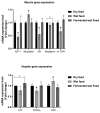Effect of Feeding Wet Feed or Wet Feed Fermented by Bacillus licheniformis on Growth Performance, Histopathology and Growth and Lipid Metabolism Marker Genes in Broiler Chickens
- PMID: 33466334
- PMCID: PMC7824773
- DOI: 10.3390/ani11010083
Effect of Feeding Wet Feed or Wet Feed Fermented by Bacillus licheniformis on Growth Performance, Histopathology and Growth and Lipid Metabolism Marker Genes in Broiler Chickens
Abstract
The present study evaluated the effect of three feeding methods (dry feed, wet feed or wet feed fermented with Bacillus licheniformis) on the growth performance, intestinal histomorphometry and gene expression of the lipid metabolism- and growth-related genes of broiler chickens. A total of 360 one-day-old Cobb-500 broiler chicks were randomly allotted into three groups containing four replicates with 30 birds each. The first group (control) was fed a dry mash basal diet. The second and third groups were fed wet feed and fermented wet feed. The final body weight and weight gain were reduced (p < 0.01) in the wet feed group, while they did not differ between the fermented wet feed and dry feed groups. Feed intake was not altered, and feeding on wet feed significantly (p < 0.01) increased the feed-to-gain ratio compared to the remaining groups. No differences between the three feeding methods in carcass characteristics, blood biochemistry and nutrient digestibility were observed except for crude protein digestibility, which was increased (p < 0.01) in the fermented wet feed group. Duodenal and ileal villi heights were elevated in birds fed fermented wet feeds, while crypt depth was not altered. The expression fold of IGF-1, GH and m-TOR genes in the pectoral muscle of birds fed wet feed was decreased (p < 0.05), while myostatin gene expression was elevated. Feeding on wet feed reduced the hepatic gene expression of PPARγ and increased that of FAS. In conclusion, wet feed negatively affected the broiler chickens' efficiency under heat stress; however, fermenting the wet feed with Bacillus licheniformis improved feed utilization and birds' performance compared to the dry feed group.
Keywords: broilers; dry feed; fermented wet feed; gene expression; intestinal morphology; performance.
Conflict of interest statement
The authors declare that they have no conflict of interest.
Figures





References
-
- Hirakawa R., Nurjanah S., Furukawa K., Murai A., Kikusato M., Nochi T., Toyomizu M. Heat stress causes immune abnormalities via massive damage to effect proliferation and differentiation of lymphocytes in broiler chickens. Front. Vet. Sci. 2020;7:46. doi: 10.3389/fvets.2020.00046. - DOI - PMC - PubMed
-
- Melesse A., Maak S., Schmidt R., Von Lengerken G. Effect of long-term heat stress on key enzyme activities and T3 levels in commercial layer hens. Inter. J. Livest. Product. 2011;2:107–116.
-
- Saleh A.A., Hayashi K., Ijiri D., Ohtsuka A. Beneficial effects of Aspergillus awamori in broiler nutrition. World’s Poult. Sci. J. 2014;70:857–864. doi: 10.1017/S0043933914000907. - DOI
-
- Afsharmanesh M., Scott T., Silversides F. A comparison of grinding processes and wet feeding of wheat-based diets on AME, production, and gastrointestinal tract development of broiler chicks. Can. J. Anim. Sci. 2006;86:255–261. doi: 10.4141/A05-072. - DOI
Grants and funding
LinkOut - more resources
Full Text Sources
Other Literature Sources
Research Materials
Miscellaneous

